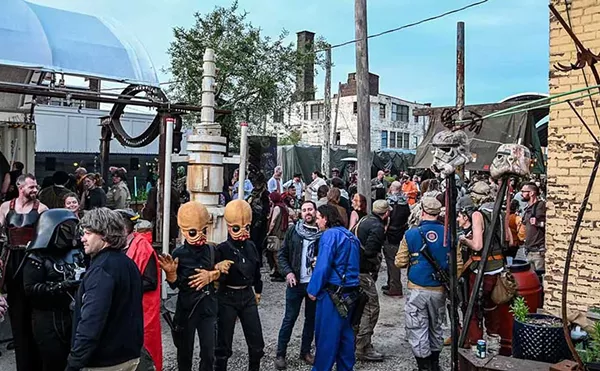
Audio By Carbonatix
[
{
"name": "GPT - Leaderboard - Inline - Content",
"component": "35519556",
"insertPoint": "5th",
"startingPoint": "3",
"requiredCountToDisplay": "3",
"maxInsertions": 100,
"adList": [
{
"adPreset": "LeaderboardInline"
}
]
}
]
Riding in a cold rainstorm on I-94 at 8 in the morning is about as far away as one can be from the exotic locales, the ingenious gadgetry and the sumptuous vixens that are part and parcel of James Bond’s imaginary world. We are heading toward “The Henry Ford” for the Bond, James Bond exhibit without a spy-gear-laden Aston Martin, or a shaker of much-needed martinis, or even a nice head of hair with an impossibly straight part.
Nope. We are schlubs. Unable to drop a slick of oil or pointy objects at tailgaters. No helicopters above, piloted by Swedish bikini models, to drop ropes and get us out of the gridlock. Nope. Just smoking Basics and looking for our exit. Schlubs. We aren’t even in the parking lot and already I can appreciate the shiny myth of “James Bond.”
“The Henry Ford” is the official new moniker for several historical attractions in Dearborn, which were usually noted singularly in the past. These include the Henry Ford Museum, Greenfield Village, the IMAX Theatre, and the Ford Rouge Factory Tour (opening in 2004).
Our destination is Henry Ford Museum, where the Bond, James Bond exhibit inaugurates the museum’s brand-new flexible gallery space. The exhibit was put together by England’s National Museum of Photography, Film & Television in partnership with Eon Productions. Henry Ford’s new space will accommodate traveling exhibitions such as the Bond exhibit (which opened in Detroit) and special collections that demand the latest multimedia equipment, lighting and creative layout. The Bond exhibit, with its innovative and whimsical use of technology, is the perfect test case for Henry Ford’s addition. The Bond show has been so well received, the museum is extending the exhibit past its original Dec. 31 closing date, to Jan. 11, 2004.
By the way, we know the Bond exhibit has been running for ages. But we also know that there are those of use who need a reminder that there are things to do in Detroit that don’t involve drinking Cosmopolitans and watching midgets dance in cages. There are alternatives to the drone of the Christmas special rerun and the forced merriment of the obligatory get-together this time of year. For once, do something just for fun, not because you have to. Leave the tinsel and nog and mangled wrapping paper at home and head to Dearborn for some real, honest-to-goodness jollies of your own.
You’ll find the Bond exhibit in a small section of the 12 acres that comprise the museum’s Great Hall. There’s no way you can avoid soaking in a bit of history before you even cast a shadow on the reception desk of BJB. This will work to your advantage. Steep in the big black implements of yore: the stoves, refrigerators, tractors, steam engines and coffee grinders of our past. These thick and ancient instruments will warm you to the clean lines and computer screens, the precise and modern artwork that you’ll find inside Bond, James Bond. You may even come across the Oscar Mayer Wienermobile, and wonder, as I did, why Sean or Roger or Timothy or Pierce never drove this particular vehicle. On your way to the exhibit, look down. You’re standing on the world’s largest teakwood floor. Henry Ford paid a million bucks for that floor in 1929. No spitting, please.
You’ll hear the goings-on in the Bond exhibit well before you are issued your “instructions” and your “smart card.” All kinds of explosions and rockets and jets taking off will bombard you as you’re checking out the cars from Die Another Day that sit just outside the exhibition space. There’s a coral-colored T-Bird that matches Halle Berry’s movie bikini, as well as a green Jaguar XKR and an Aston Martin (of course) Vanquish. Ford Motor Co. loaned these cars to the exhibit to add a bit of automotive heft to the whole affair. Car guys and car gals will drool. I was more impressed with the Wienermobile.
There’s a reason you need instructions and smart cards. You are an active participant in every aspect of Bond, James Bond. You don’t walk around and look at stuff on the walls with your index finger and thumb on your chin. You are an agent-in-training. Your card will allow you to be tracked, monitored and rated as you wind through the various modules. The modules have broken down the James Bond film into a formula, presenting information to you as if your career as a “special agent” depended on it.
Before you get to use this gadget, you are invited to watch a short film about the Cold War. While watching grainy images of Julius and Ethel Rosenberg and Kim Philby and Francis Gary Powers and the U2 plane that almost started a war, you’ll realize this film is being shown on a simulated chunk of the Berlin Wall, barbed wire and all. Talk about your interactive, multimedia immersion. This film gives a sense of the time and place from which the novels of Ian Fleming sprung. James Bond was going to save us from all those people with accents and bald heads who had big plans to blow up the world with devilishly phallic weaponry. Ian had a rich store of paranoia and reality to mine.
After this sobering little history lesson, your mission takes you to a couple of computer kiosks. These allow you to explore the artists and composers who created the Bond music and title sequences, and let you get acquainted with how the rest of this experience is going to work. To fully appreciate all the exhibit has to offer, using the kiosks is essential. You will register as one of three types of agents: novice, general or super. As you explore each module throughout the exhibit, you will swipe your card into the appropriate kiosk to dig for information about the various personalities or equipment behind the James Bond movies. Top Secret information can only be garnered by successfully answering a question pertaining to something you have experienced previously in the exhibit. You have a limited amount of time allowed on each kiosk, so you have to be quick about it. This is doubly hard because these are very sophisticated devices that don’t only give information in a static fashion; they also feature video and sound as well. Your manic finger-punching of the screen will simulate the time imperative in every Bond flick. (“Hurry, James. You must hurry.”) This works hair-pullingly well.
After registration, you’ll find yourself in the office of M, chief of MI6, England’s secret service. Three actors have played this role in the Bond flicks, Dame Judi Dench being the latest. Ian Fleming had M go by just one initial in imitation of the actual founder of the MI6, Captain Mansfield, who signed all documents with a capital C. You soon learn that Fleming didn’t have to dream up all these tricks of the trade. He often had real-life inspiration drawn from his experiences in the English government to round out his stories. I’m not exactly sure of the finer details of Fleming’s background because my time ran out on that particular kiosk, dooming me to novice agent status. I was informed I could go home and enter my agent number on the exhibit’s Web site, whose address is printed on the card, for more in-depth investigations. Cute.
Each module has its own paraphernalia and its own specific charms. Besides the database at your fingertips, there are props, drawings, models and interactive displays to complete your education. At “Q’s Workshop,” you’ll not only be briefed on much of the gadgets and weapons and survival gear Bond was lucky enough to have, you’ll also see the drawings the art department used for many that never made it to the screen.
You’ll see the actual Cocktail Grenade used in Goldfinger and the Omega watch that doubled as a blowtorch in The World is Not Enough, as well as the Phillishave Bug Detector (an electric shaver that can also detect microphones in a room) from A View to a Kill. Very quaint by today’s high-tech standards, these items nonetheless will impart a nostalgia for the mod and sleek of the ’60s and early ’70s. It’s pre-laptop, pre-GPS, pre-cell phone, but still humming with the industrial designs of spy-cool. Students and aficionados of art and fashion and design will glean much from BJB. It’s not just for the Bond freaks. You’ll see the scientific and artistic sweat that went into all these amusements.
In the “Rogue” module you’ll put yourself in a darkened room where four of Bond’s greatest nemeses have their holographic heads imprisoned within long rectangular blocks that rise from the floor. As you stare into their menacing mugs, their faces begin to fade, and their famous weapons of choice are revealed. From Live and Let Die, you’re offered Jaws’ shimmering teeth. From Goldfinger, Oddjob’s statue-decapitating bowler. The flick-knife shoes of Rosa Kleb in From Russia with Love have an intense cruelty all their own. The cream of this murderous crop is the gun from The Man with the Golden Gun. Ballpoint pen, cigarette lighter, cigarette case and cuff link. Put ’em all together and whaddya got? Danger, my friend. Elegant, sophisticated danger.
There’s a module on the women featured in the Bond films, as well as the actual costumes worn by these gorgeous dolls as they flirted, caroused, distracted and threatened Bond throughout his adventures. Kissy Suzuki, Honey Ryder, Dr. Holly Goodhead are all represented.
There’s a fascinating module on the stunts used in the films. You can access the video file on this module’s kiosk and watch incredible deconstructions of alligator-hopping, hydroplane-jumping, and other choreographed mayhem. You can also participate in re-creating the Golden Gate Bridge sequence from A View to a Kill with the help of some video trickery and a huge orange pipe. The kiddies will want to spend way too much time on this particular attraction.
Bond, James Bond is perfectly suited for the museum that houses it. It’s all ingenuity, innovation, design and invention. Right next door to the Bond exhibit is the Dymaxion House, R. Buckminster Fuller’s 1946 idea of the “perfect” home. Aluminum, Naugahyde, Plexiglas, and a few other cheap materials could have changed our landscape for good. But they didn’t. Why didn’t they? Ask the tour guide; he knows everything.
From the unbelievably massive steam engines that powered not-so-modern revolutions to the 1940s roadside diner that ends a long parade of jalopies great and small, the Henry Ford Museum is an inspiring place. It marks the evolution of sewing machines, wooden chairs, computers, locomotives, airplanes, and thousands of other mechanical marvels. It captures the minds, displays the workshops of those who created the objects we were and are surrounded by. It’s worth an afternoon of your time.
Dan DeMaggio is a freelance writer. E-mail letters@metrotimes.com




